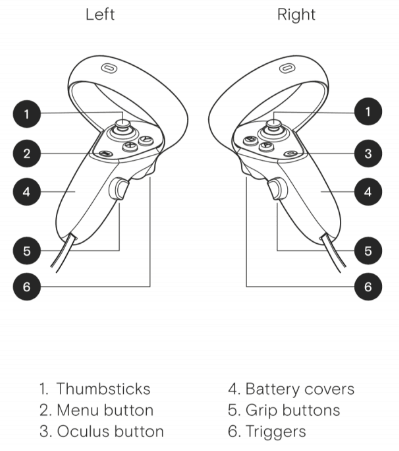热门标签
热门文章
- 1SAP Customer Checkout Troubleshoot and FAQ
- 2Django REST framework中认证和权限的使用方法_django restful 鉴权
- 3Nodejs: MemoryUsage()返回的rss,heapTotal,heapUsed,external的含义和区别_process.memoryusage
- 4Kubernetes/Docker口口相传,它们之间标准到底是什么?由谁来决定?_runtime spec
- 5Java排序的那些事之sort方法的使用详解_java sort
- 6iOS - MJRefresh使用详解_ios mjrefresh语言
- 7如何使用Docker本地部署Jupyter Notebook并结合内网穿透实现远程访问_威联通docker jupyter notebook
- 8Linux与windows互相传输文件之rzsz命令_rzsz如何使用
- 9企业微信+讯飞AI推送每日情侣问候_讯飞星火的应用有微信api接口吗
- 10Codeforces Round #700 (Div. 2) D1. Painting the Array I (贪心)_codeforces painting the array i
当前位置: article > 正文
Unity在XR设备中获取手柄的按键信息_unity openxr primarybutton
作者:菜鸟追梦旅行 | 2024-02-16 02:04:14
赞
踩
unity openxr primarybutton
我们在平常的XR设备开发中,尤其适用VR设备的时候,会用到手柄的操作。


我们知道Oculus SDK提供了OVRInput,能够获取得到手柄的按键信息。
- // public variable that can be set to LTouch or RTouch in the Unity Inspector
- public Controller controller;
-
- // returns a float of the Hand Trigger’s current state on the Oculus Touch controller
- // specified by the controller variable.
- OVRInput.Get(OVRInput.Axis1D.PrimaryHandTrigger, controller);
-
- // returns true if the primary button (“A” or “X”) is pressed on the Oculus Touch controller
- // specified by the controller variable.
- OVRInput.Get(OVRInput.Button.One, controller);
因为我们开发的应用肯定不单单只在oculus上运行,如果在其他的VR设备上运行的话,那要对接各个VR设备的SDK吗?
不用慌,其实Untiy已经把这个事情帮我做了,Unity封装了一下XR Input接口,就是抽象出来一层,能够在各种VR设备上使用。
那如何使用呢?我们先看看Unity封装的各个按键的对应关系。已经支持了很多市面上的VR设备。主要还是Oculus。你可以去官网上进行参考:Unity - Manual: Unity XR Input

我对使用方法进行了封装,挂载GameObject上就可以使用了。大家可以自行使用啊。
- using System.Collections.Generic;
- using UnityEngine;
- using UnityEngine.Events;
- using UnityEngine.XR;
-
- [System.Serializable]
- public enum InputFeature
- {
- //
- // ժҪ:
- // The primary face button being pressed on a device, or sole button if only one
- // is available.
- primaryButton,
- //
- // ժҪ:
- // The primary face button being touched on a device.
- primaryTouch,
- //
- // ժҪ:
- // The secondary face button being pressed on a device.
- secondaryButton,
- //
- // ժҪ:
- // The secondary face button being touched on a device.
- secondaryTouch,
- //
- // ժҪ:
- // A binary measure of whether the device is being gripped.
- gripButton,
- //
- // ժҪ:
- // A binary measure of whether the index finger is activating the trigger.
- triggerButton,
- //
- // ժҪ:
- // Represents a menu button, used to pause, go back, or otherwise exit gameplay.
- menuButton,
- //
- // ժҪ:
- // Represents the primary 2D axis being clicked or otherwise depressed.
- primary2DAxisClick,
- //
- // ժҪ:
- // Represents the primary 2D axis being touched.
- primary2DAxisTouch,
- //
- // ժҪ:
- // Represents the secondary 2D axis being clicked or otherwise depressed.
- secondary2DAxisClick,
- //
- // ժҪ:
- // Represents the secondary 2D axis being touched.
- secondary2DAxisTouch,
- //
- // ժҪ:
- // Use this property to test whether the user is currently wearing and/or interacting
- // with the XR device. The exact behavior of this property varies with each type
- // of device: some devices have a sensor specifically to detect user proximity,
- // however you can reasonably infer that a user is present with the device when
- // the property is UserPresenceState.Present.
- userPresence
- }
-
- public class XRControllerButtonWatcher : MonoBehaviour
- {
- private Dictionary<InputFeature, InputFeatureUsage<bool>> inputFeatureUsageMap = new Dictionary<InputFeature, InputFeatureUsage<bool>>() {
- { InputFeature.primaryButton, CommonUsages.primaryButton },
- { InputFeature.primaryTouch, CommonUsages.primaryTouch },
- { InputFeature.secondaryButton, CommonUsages.secondaryButton },
- { InputFeature.secondaryTouch, CommonUsages.secondaryTouch },
- { InputFeature.gripButton, CommonUsages.gripButton },
- { InputFeature.triggerButton, CommonUsages.triggerButton },
- { InputFeature.menuButton, CommonUsages.menuButton },
- { InputFeature.primary2DAxisClick, CommonUsages.primary2DAxisClick },
- { InputFeature.primary2DAxisTouch, CommonUsages.primary2DAxisTouch },
- { InputFeature.secondary2DAxisClick, CommonUsages.secondary2DAxisClick },
- { InputFeature.secondary2DAxisTouch, CommonUsages.secondary2DAxisTouch },
- { InputFeature.userPresence, CommonUsages.userPresence }
- };
-
- [SerializeField]
- public InputFeature ButtonInputFeature;
-
- [SerializeField]
- public InputDeviceCharacteristics inputDeviceType = InputDeviceCharacteristics.None;
-
- [SerializeField]
- public UnityEvent OnInputDown;
-
- [SerializeField]
- public UnityEvent OnInputUp;
-
- private InputFeatureUsage<bool> buttonInputFeatureUsage;
-
- private bool lastButtonState = false;
- private List<InputDevice> devicesButton;
-
- private void Awake()
- {
- if (OnInputDown == null)
- OnInputDown = new UnityEvent();
- if (OnInputUp == null)
- OnInputUp = new UnityEvent();
-
- devicesButton = new List<InputDevice>();
-
- if (!inputFeatureUsageMap.TryGetValue(ButtonInputFeature, out buttonInputFeatureUsage))
- {
- Debug.LogError("not found inputFeature: " + ButtonInputFeature);
- }
- }
-
- private void OnEnable()
- {
- Init();
- }
-
- private void OnDisable()
- {
- InputDevices.deviceConnected -= InputDevices_deviceConnected;
- InputDevices.deviceDisconnected -= InputDevices_deviceDisconnected;
- devicesButton.Clear();
- }
-
- private void InputDevices_deviceConnected(InputDevice device)
- {
- bool discardedValue;
- if (device.TryGetFeatureValue(buttonInputFeatureUsage, out discardedValue))
- {
- Debug.Log($"add device: {device.name}");
- devicesButton.Add(device); // Add any devices that have a primary button.
- }
- }
-
- private void InputDevices_deviceDisconnected(InputDevice device)
- {
- if (devicesButton.Contains(device))
- devicesButton.Remove(device);
- }
-
- private void Update()
- {
- bool tempState = false;
- foreach (var device in devicesButton)
- {
- bool primaryButtonState = false;
- tempState = device.TryGetFeatureValue(buttonInputFeatureUsage, out primaryButtonState) // did get a value
- && primaryButtonState // the value we got
- || tempState; // cumulative result from other controllers
- }
-
- if (tempState != lastButtonState) // Button state changed since last frame
- {
- if (tempState)
- OnInputDown?.Invoke();
- else
- OnInputUp?.Invoke();
-
- lastButtonState = tempState;
- }
- }
-
- public void Init()
- {
- List<InputDevice> allDevices = new List<InputDevice>();
- if (inputDeviceType == InputDeviceCharacteristics.None)
- InputDevices.GetDevices(allDevices);
- else
- InputDevices.GetDevicesWithCharacteristics(inputDeviceType, allDevices);
-
- foreach (InputDevice device in allDevices)
- InputDevices_deviceConnected(device);
-
- InputDevices.deviceConnected += InputDevices_deviceConnected;
- InputDevices.deviceDisconnected += InputDevices_deviceDisconnected;
- }
- }

使用Unity自带的XR Input可以很好的支持多种设备。不需要再一个一个对接各个VR设备的SDK中的Input了。
参考文档:
声明:本文内容由网友自发贡献,不代表【wpsshop博客】立场,版权归原作者所有,本站不承担相应法律责任。如您发现有侵权的内容,请联系我们。转载请注明出处:https://www.wpsshop.cn/w/菜鸟追梦旅行/article/detail/89656
推荐阅读
相关标签





